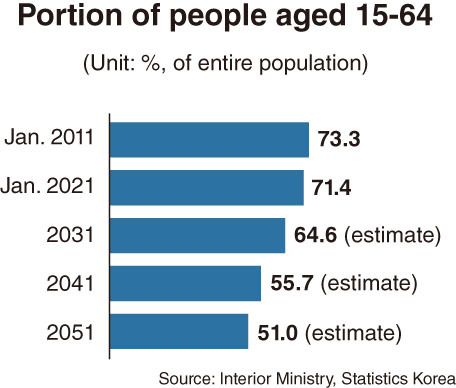[News Focus] Korea’s working-age population falls to 23-year low
Portion of people aged 15-64 in steep decline
By Kim Yon-sePublished : Feb. 28, 2021 - 16:05

SEJONG -- The percentage of working age population in South Korea fell to its lowest level in more than two decades, in the wake of continuously falling births and an ageing population, latest data showed.
The nation has seen a gradually declining number of newborns since the 1990s and an ongoing entry of baby boomers -- people born between 1955-1963 -- to the senior population, which started in January 2020.
According to the Ministry of Interior and Safety, the proportion of people, aged between 15-64, stayed at 71.4 percent -- 36.99 million of the entire 51.82 million population -- as of January 2021.
After peaking at 73.4 percent from October 2011 to January 2012, their portion has continued to fall over the past nine years, rapidly declining in the past two or three years.
As a result, the figure for last month marked the lowest in about 23 years since it posted 71.4 percent in December 1997, when the Asian currency crisis hit the nation. It was 71 percent in December 1996 and 71.6 percent in December 1998.
The nation has seen a gradually declining number of newborns since the 1990s and an ongoing entry of baby boomers -- people born between 1955-1963 -- to the senior population, which started in January 2020.
According to the Ministry of Interior and Safety, the proportion of people, aged between 15-64, stayed at 71.4 percent -- 36.99 million of the entire 51.82 million population -- as of January 2021.
After peaking at 73.4 percent from October 2011 to January 2012, their portion has continued to fall over the past nine years, rapidly declining in the past two or three years.
As a result, the figure for last month marked the lowest in about 23 years since it posted 71.4 percent in December 1997, when the Asian currency crisis hit the nation. It was 71 percent in December 1996 and 71.6 percent in December 1998.

While local economists say the shrinking percentage of those aged 15-64 would have a negative effect of scaling back the growth of gross domestic product, official demographic estimates are aggravating the worries.
Data held by Statistics Korea forecasts that the proportion of the working age population will fall below 70 percent to 69.9 percent by 2024.
The state-run agency also predicts that this figure would be less than 60 percent (59.8 percent) in 2036 and less than 50 percent (49.9 percent) in 2056.
The size of the senior population, aged 65 or over, is projected to overtake the working age population in 2065, when the tally for those aged 15-64 will comprise 45.9 percent of the total and seniors 46.1 percent.
These estimates are based on the world’s lowest-level fertility rates that dropped to under 1.0 in 2018.
In January, the number of children under 10 years of age was only 3.92 million -- putting this age group at the bottom of the rankings among age groups under 70 in Korea.
People in their 50s topped the list with 8.64 million, followed by those in their 40s with 8.28 million, those in their 30s with 6.85 million and those in their 20s with 6.79 million.
In addition, those aged 60-69 outnumbered people aged 10-19 at 6.79 million to 4.78 million.
The tally for Koreans aged 70-79 reached an all-time high of 3.7 million. Those in their 80s and 90s, as well as centenarians, also posted record numbers of 1.74 million, 255,030 and 22,120, respectively.
For a wider comparison, the number of people aged 0-19 (8.72 million) was down by more than 1.7 million than people aged 60-79 (10.5 million) as of last month.
Korea recorded a fertility rate of 1.654 in 1993, when the government started compiling official statistics. That level, though relatively low, was still enough to ensure a sustainable working age population.
The rate is estimated to have surpassed 2.0 in the early 1980s and 4.0 in the early 1970s, according to unofficial statistics.
But it continued to slide in the 1990s and 2000s and posted 1.187 in 2013. The figure for 2018 was 0.977, falling below the 1.0-mark for the first time in history, and since then has declined to 0.92 in 2019 and 0.84 in 2020, Statistics Korea data showed.
In 1970, South Koreans aged 14 and under made up 42.5 percent of the population, which was No. 2 among members of the Organization for Economic Cooperation and Development, in a retrospective comparison of its 37 members.
But Korea has posted the steepest decline in the percentage for the youngest age group among the members since then. Interior Ministry data showed that their portion stayed at 12.1 percent as of January.
By Kim Yon-se (kys@heraldcorp.com)








![[Kim Seong-kon] Democracy and the future of South Korea](http://res.heraldm.com/phpwas/restmb_idxmake.php?idx=644&simg=/content/image/2024/04/16/20240416050802_0.jpg&u=)







![[KH Explains] Hyundai's full hybrid edge to pay off amid slow transition to pure EVs](http://res.heraldm.com/phpwas/restmb_idxmake.php?idx=652&simg=/content/image/2024/04/18/20240418050645_0.jpg&u=20240418181020)

![[Today’s K-pop] Zico drops snippet of collaboration with Jennie](http://res.heraldm.com/phpwas/restmb_idxmake.php?idx=642&simg=/content/image/2024/04/18/20240418050702_0.jpg&u=)